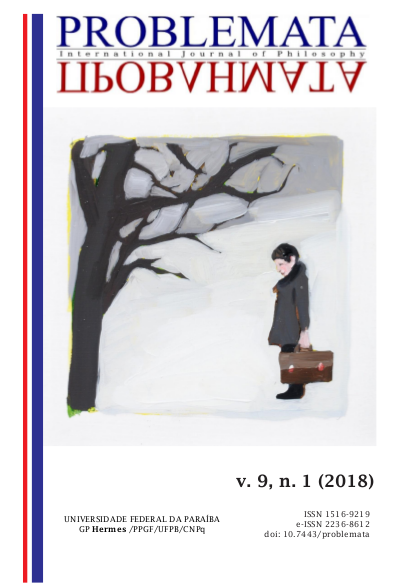ADDICTION IN SCREENS: CONTRIBUTIONS OF THE THOUGHT OF CHRISTOPH TÜRCKE FOR THE CORPORAL EDUCATION
DOI:
https://doi.org/10.7443/problemata.v9i1.38718Keywords:
Addiction, Digital Screens, Corporeity, Education, Alienation.Abstract
This essay illustrates the results of a critical reflection on the possible permanent consequences for people in front of screens, which transmit images supported by electronic devices. It aims to reflect on the education of movement and an awareness of the formation itself, regarding the subject as a corporeal and sensitive being. In the first section are highlighted aspects of a historical and social trend in the practices of physical activities, which integrate the moving images transmitted by the most diverse types of display devices to stimulate people to move. Secondly, such a trend is reflected in the theory of the German philosopher Christoph Türcke, especially regarding his arguments about the permanent flow of microshocks from electronic screens, and their effects on the capacity of representation and human perception. The hypothesis of the text is that the integration of the screens from the electronic-imagery to the practices of physical activities, devoid of critical historical-social reflection, tends to make it even more difficult for people to realise the consequences of audio-visual stimulation on their own bodies, as well as on their relationships with what is actually in their surroundings, the result of which may be bodily alienation.
Downloads
References
ADORNO, T. W; HORKHEIMER, M. Dialética do Esclarecimento: fragmentos filosóficos. Rio de Janeiro, Jorge Zahar Ed., 1985.
______. Teoria da Semiformação. In: PUCCI, B. ZUIN, A.A.S. LASTÓRIA, L.A.C.N. Teoria Crítica e Inconformismo: novas perspectivas de pesquisa. Campinas: Autores Associados, pp. 07-40, 2010.
______. Teoria Estética. Tradução de Artur Morão. Lisboa: Edições 70, [s.d]. Arte e Comunicação: 14.
______. Experiência e Criação Artística: paralipómenos à Teoria Estética. Tradução de Artur Morão. Lisboa: Edições 70, [s.d]. Arte e Comunicação: 14.
______. Theodor W. Adorno. Notas sobre o filme, In: ADORNO, T.W. Theodor W. Adorno. Tradução de Gabriel Cohn. São Paulo: Editora Ática, 1994. Lisboa: Edições 70, [s.d]. Arte e Comunicação: 14.
BENJAMIN, W. Sobre alguns temas em Baudelaire. In: BENJAMIN, W. Charles Baudelaire, um lírico no auge do capitalismo. Trad. José Carlos Martins Barbosa e Hemerson Alves Baptista. 1ª ed. São Paulo, Brasiliense, 1989, 271 p.
______. A obra de arte na era da sua reprodutibilidade técnica. (Trad. S. P. Rouanet) In: Obras Escolhidas (vol. 1) Magia e técnica arte e política: ensaios sobre literatura e história da cultura. São Paulo: Brasiliense, 1994.
BENJAMIN, W, SCHÖTTCKER, D., BUCK-MORSS, S. , HANSEN, M. Benjamin e a obra de arte: técnica, imagem, percepção. Rio de Janeiro, Contraponto, 2012.
COSTA, A. Q. Jogos digitais e Educação Física: por uma experiência corporal educativa, p.71, In. Diálogo entre educação física e comunicação: compartilhando saberes e práticas / organizadores Allyson Carvalho de Araújo... [et.al.]. – Natal, RN : EDUFRN, 2016
______. Comunicação e Jogos Digitais em ambientes educacionais: Literacias de Mídia e Informação dos professores de Educação Física da cidade de São Paulo. 2017. 257f. Tese (Doutorado). Escola de Comunicações e Artes, Universidade de São Paulo, São Paulo, 2017.
GAGNEBIN, J. M. Sobre as relações entre ética e estética no pensamento de Adorno. In: Newton Ramos-de-Oliveira; Antonio Álvaro Soartes Zuin; Bruno Pucci. (Org.). Teoria crítica, estética e Educação. 1ed.Piracicaba e São Paulo: Ed. UNIMEP e FAPESP, 2001, v. 1, p. 61-74.
GRAZIELE BENTO, G.; CASCAES DA SILVA, F.; GONÇALVES, E.; DOMINGOS DOS SANTOS, P.; SILVA, R. Revisão sistemática sobre nível de atividade física e estado nutricional de crianças brasileiras. Revista de Salud Pública: Universidad Nacional de Colombia, Bogotá, vol. 18, núm. 4, agosto, 2016, pp. 630-642. Disponível em: <http://www.redalyc.org/articulo.oa?id=42247581011> Acesso em 29.09.2017.
MARX, K. O capital: crítica da economia política. Tradução: Reginaldo Sant’anna. Livro 1, 14ª. Edição. Rio de Janeiro: Editora Bertrand, 1994.
PUCCI, B. A dialética negativa enquanto metodologia de pesquisa em Educação: atualidades. Revista e-curriculum. São Paulo, v. 8, n.1, p. 1-24, abr. 2012.
SOUZA, D. F.; FARIAS, M. N. Problematizando os discursos sobre Saúde e Riscos à Saúde nas produções acadêmicas da Educação Física. In: X Congresso Internacional de Teoria Crítica, 2016, São Carlos. Anais do X Congresso Internacional de Teoria Crítica: tecnologia, violência, memória. São Carlos: Edufscar, 2016. v. 1. p. 152-159.
TÜRCKE, C. Sociedade Excitada: filosofia da sensação. Trad. A. Zuin, F. Durão, F. Fontanella & M. Frungillo. Campinas: Editora da UNICAMP, 2010a.
______. Filosofia do sonho. Trad. P. R. Schneider. Ijuí: Editora Unijuí, 2010b.
WIGGERSHAUS, R. A Escola de Frankfurt: História, Desenvolvimento Teórico, Significação Política. São Paulo: Difel, 2005.
Downloads
Published
Issue
Section
License
Authors who publish with this journal agree to the following terms:
- Authors retain copyright and grant the journal right of first publication with the work simultaneously licensed under a Creative Commons Attribution License that allows others to share the work with an acknowledgement of the work's authorship and initial publication in this journal.
- Authors are able to enter into separate, additional contractual arrangements for the non-exclusive distribution of the journal's published version of the work (e.g., post it to an institutional repository or publish it in a book), with an acknowledgement of its initial publication in this journal.
-
- Authors are permitted and encouraged to post their work online (e.g., in institutional repositories or on their website) prior to and during the submission process, as it can lead to productive exchanges, as well as earlier and greater citation of published work (See The Effect of Open Access).





